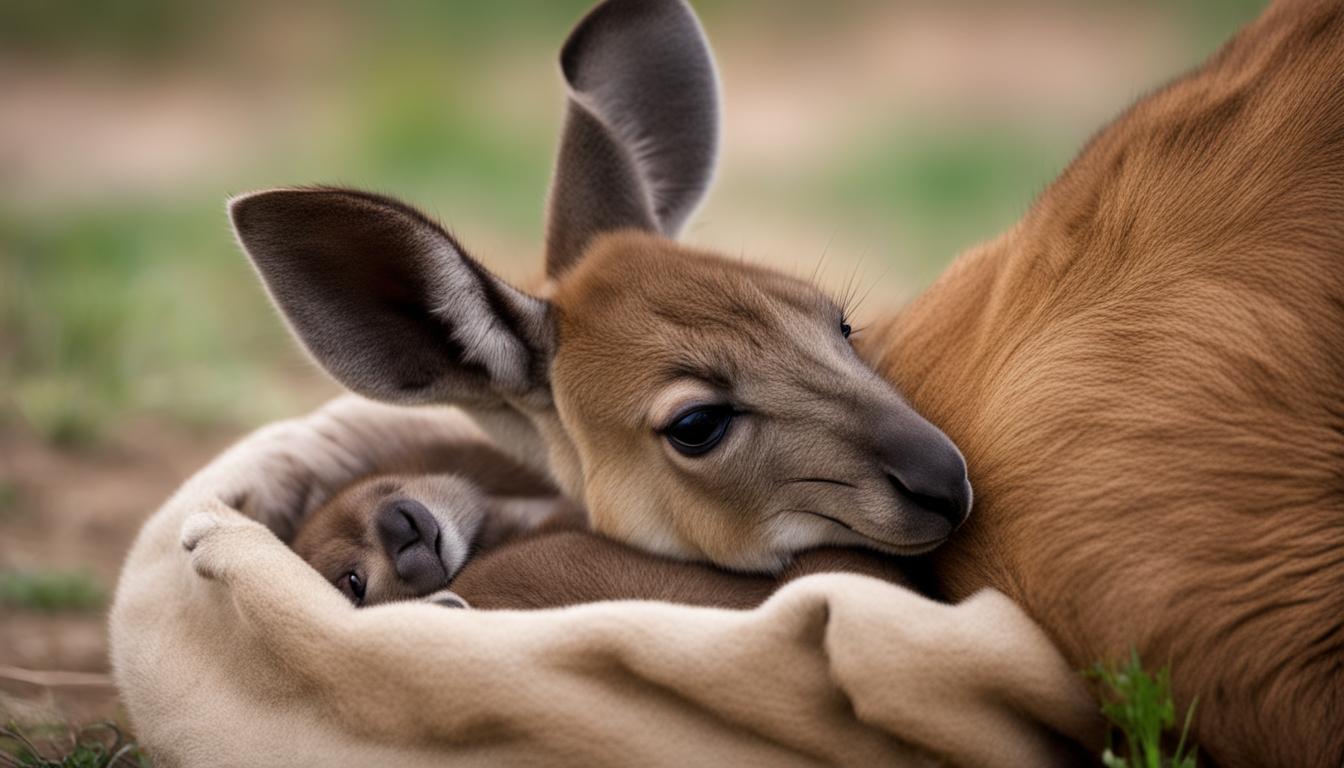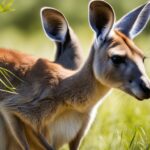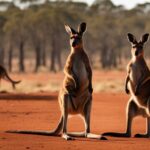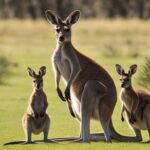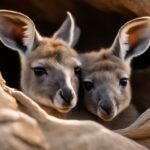Welcome to our fascinating exploration of baby kangaroo development! In this article, we will delve into the unique journey of kangaroo joeys, from their birth to their growth and independence. Get ready to discover the incredible adaptations, care, and facts about these adorable creatures.
Did you know that baby kangaroos, known as joeys, have a one-of-a-kind development process? They are born after a short gestation period and are only about 1 inch in length at birth. But what is truly remarkable is how they continue to grow and thrive inside their mother’s pouch.
Once born, joeys crawl their way into their mother’s pouch, where they find comfort and nourishment. They latch onto a nipple and receive a constant supply of specialized milk, which plays a crucial role in their growth. This kangaroo care ensures that joeys receive the necessary nutrients for each stage of their development.
Over the next 6 to 9 months, the joey gradually develops inside the pouch, gaining strength and size. It’s an incredible journey as the joey’s body goes through various growth stages, adapting to the changing milk composition provided by the mother.
Kangaroo mothers can have multiple joeys at different stages of development, thanks to a process called embryonic diapause. This fascinating adaptation allows them to pause the growth of one embryo while caring for another, ensuring the survival of their young.
Stay with us as we dive deeper into the reproductive process of kangaroos, the life inside the mother’s pouch, and the journey to independence for these amazing baby kangaroos.
The Reproductive Process of Kangaroos
Kangaroos, as marsupials, have a fascinating reproductive process that sets them apart from other mammals. Females have two vaginas and two uteri, allowing them to give birth to two separate embryos simultaneously. Unlike placental mammals, fertilization occurs through the cloaca, a common opening for the digestive, reproductive, and urinary systems. The embryos develop outside the uterus, enclosed in specialized coats and shells.
One of the most remarkable features of kangaroo reproduction is embryonic diapause. This unique adaptation allows the mother to pause the growth of one embryo while another continues to develop. By controlling the timing of birth, kangaroos can ensure the survival of their offspring based on factors such as food availability and environmental conditions.
During courtship and mating, kangaroos engage in interesting behaviors. Male kangaroos often engage in dominant fights, known as “boxing,” where they use their powerful hind legs to kick and grapple with their opponents. These fights determine the dominant male who will have the opportunity to mate with the female. This behavior is not only a display of strength but also a way to impress the female and secure mating rights.
Kangaroo Reproduction in Summary:
- Kangaroos have two vaginas and two uteri, allowing them to give birth to two separate embryos.
- Fertilization occurs through the cloaca, a common opening for the digestive, reproductive, and urinary systems.
- Embryos develop outside the uterus, enclosed in specialized coats and shells.
- Embryonic diapause allows kangaroos to pause the growth of one embryo while another progresses.
- Kangaroos engage in dominant fights, or “boxing,” during courtship and mating.
Understanding the reproductive behaviors and adaptations of kangaroos provides valuable insights into the unique life cycle and survival strategies of these amazing marsupials.
Life in the Mother’s Pouch
The mother’s pouch is a remarkable adaptation that plays a vital role in the development of baby kangaroos, or joeys. After birth, the joey crawls through its mother’s fur and into the pouch, where it latches onto a nipple for nourishment. This unique pouch provides a nurturing environment for the joey’s growth and development.
The mother kangaroo’s pouch is specifically designed to accommodate the young joey. The nipple within the pouch inflates to hold the joey in place, ensuring a secure attachment. The pouch also offers protection and warmth, creating an ideal space for the joey to grow.
Inside the pouch, the mother kangaroo produces specialized milk that adapts to the joey’s growth needs. This milk contains high protein, carbohydrates, and fats, providing the essential nutrients for the joey’s development. As the joey grows, the composition of the milk changes to meet its evolving nutritional requirements. This tailored nutrition allows the joey to thrive and develop at a healthy pace.
The joey remains in the pouch for approximately 6 to 9 months, gradually gaining strength and developing its muscles. As it grows, the joey starts to explore the world outside the pouch, occasionally poking its head out to observe its surroundings. This gradual process prepares the joey for eventual independence, as it becomes more capable of venturing out on its own.
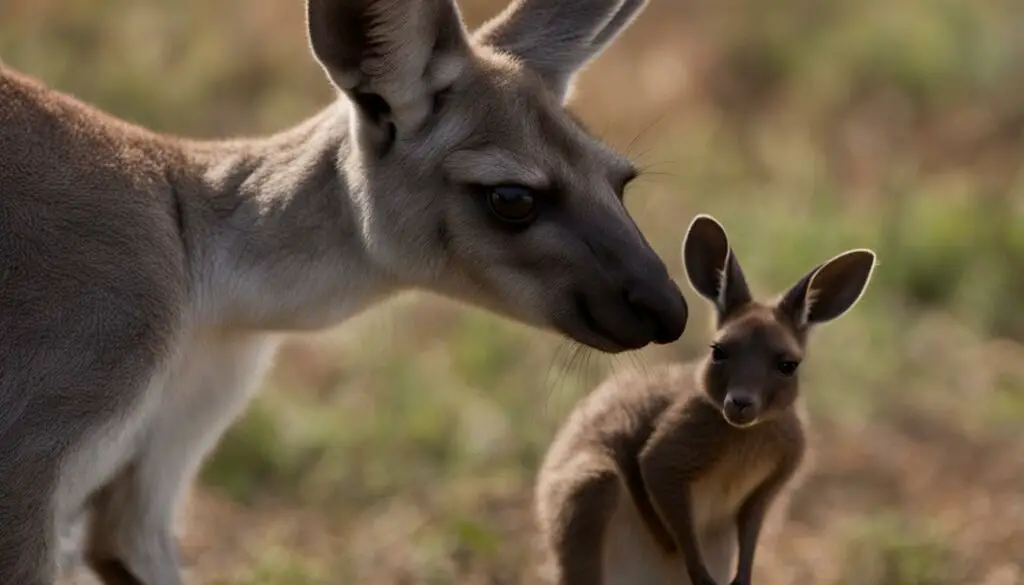
The Journey to Independence
As baby kangaroos, or joeys, grow and develop inside their mother’s pouch, they go through an incredible journey towards independence. At around 6 months old, joeys begin to venture out of the pouch, taking short trips to explore the world around them. These excursions help them gain strength and practice their walking skills.
By the time they reach 8 months old, joeys are fully independent and no longer rely on their mother’s pouch for protection and nourishment. However, they continue to feed on their mother’s milk for up to a year, gradually transitioning to grazing as they develop their ability to find and consume solid food.
Witnessing the transformation of a tiny, helpless joey into a fully independent kangaroo is truly remarkable. It showcases the resilience and adaptability of these fascinating creatures, as they grow, learn, and thrive in their natural environment.
Throughout their journey to independence, joeys are guided by their innate instincts and the nurturing care of their mothers. This process not only ensures the survival of the young kangaroos but also contributes to the continued growth and sustainability of the kangaroo population.
The Fascinating Growth of Baby Kangaroos
The development and growth of baby kangaroos, or joeys, is truly remarkable. These adorable creatures undergo a series of stages in their journey to adulthood, showcasing incredible adaptations along the way.
After a short gestation period, joeys are born and immediately crawl into their mother’s pouch. Inside the pouch, they receive specialized milk that adapts to their growth needs. This milk provides the essential nutrients necessary for their development, ensuring they thrive and grow.
As months pass by, the joey gradually emerges from the pouch, venturing into the outside world and gaining strength. By around 6 to 8 months old, the joey becomes fully independent, no longer relying on the pouch for shelter and sustenance.
While the joey may have left the pouch, they continue to rely on their mother’s milk for a while longer. It’s a gradual transition as they learn to graze and feed on other sources of nourishment. This period of growth and independence marks a significant milestone in the kangaroo life cycle.
How Does a Kangaroo’s Anatomy and Body Structure Affect the Development and Growth of a Baby Kangaroo?
The anatomy and body structure of kangaroo plays a crucial role in the development and growth of a baby kangaroo. The female kangaroo has a pouch where the underdeveloped joey stays until it is mature enough to survive outside. This unique feature allows the joey to continue developing in safety.
FAQ
How do baby kangaroos (joeys) develop and grow?
Baby kangaroos, or joeys, are born after a short gestation period and crawl into their mother’s pouch. They latch onto a nipple and receive specialized milk that adapts to their growth needs. It takes around 6 to 9 months for a joey to fully develop and leave the pouch.
What is the reproductive process of kangaroos?
Female kangaroos have two vaginas and two uteri, enabling them to give birth to two separate embryos. Fertilization occurs through the cloaca, and the embryos develop outside the uterus, nourished by specialized coats and shells. Kangaroos also have a unique adaptation called embryonic diapause, where the development of one embryo is paused while the other progresses.
How does life in the mother’s pouch work?
After birth, joeys crawl through their mother’s fur and enter the pouch, where they latch onto a nipple. The mother’s pouch provides a nurturing environment for the joey’s growth and development. The milk she produces is specifically tailored to the joey’s growth stage, with the composition changing as the joey grows.
What is the journey to independence like for baby kangaroos?
As joeys grow and develop in the pouch, they start to poke their heads out and explore the outside world. At around 6 months old, they begin making short trips out of the pouch to gain strength and practice walking. By 8 months old, the joey is fully independent and no longer relies on the pouch.
What is fascinating about the growth of baby kangaroos?
The development and growth of baby kangaroos, or joeys, is a remarkable process. From their unique reproductive system to the nurturing care provided by their mothers, joeys go through a series of stages in their journey to adulthood. They demonstrate incredible adaptations to ensure their survival and success, making them truly fascinating creatures to study.

